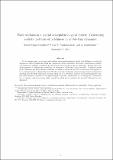Files in this item
Wave of chaos in a spatial eco-epidemiological system : generating realistic patterns of patchiness in rabbit-lynx dynamics
Item metadata
| dc.contributor.author | Upadhyay, Ranjit | |
| dc.contributor.author | Roy, Parimita | |
| dc.contributor.author | Venkataraman, C. | |
| dc.contributor.author | Madzvamuse, Anotida | |
| dc.date.accessioned | 2017-09-14T23:32:19Z | |
| dc.date.available | 2017-09-14T23:32:19Z | |
| dc.date.issued | 2016-11 | |
| dc.identifier | 245646544 | |
| dc.identifier | 373997f8-2728-4091-8fbd-2fe02b50d770 | |
| dc.identifier | 84990188798 | |
| dc.identifier | 000387191900011 | |
| dc.identifier.citation | Upadhyay , R , Roy , P , Venkataraman , C & Madzvamuse , A 2016 , ' Wave of chaos in a spatial eco-epidemiological system : generating realistic patterns of patchiness in rabbit-lynx dynamics ' , Mathematical Biosciences , vol. 281 , pp. 98-119 . https://doi.org/10.1016/j.mbs.2016.08.014 | en |
| dc.identifier.issn | 0025-5564 | |
| dc.identifier.uri | https://hdl.handle.net/10023/11666 | |
| dc.description | AM and CV would like to acknowledge support from the Engineering and Physical Sciences Research Council grant (EP/J016780/1) and the Leverhulme Trust Research Project Grant (RPG-2014-149). | en |
| dc.description.abstract | In the present paper, we propose and analyse an eco-epidemiological model with diffusion to study the dynamics of rabbit populations which are consumed by lynx populations. Existence, boundedness, stability and bifurcation analyses of solutions for the proposed rabbit-lynx model are performed. Results show that in the presence of diffusion the model has the potential of exhibiting Turing instability. Numerical results (finite difference and finite element methods) reveal the existence of the wave of chaos and this appears to be a dominant mode of disease dispersal. We also show the mechanism of spatiotemporal pattern formation resulting from the Hopf bifurcation analysis, which can be a potential candidate for understanding the complex spatiotemporal dynamics of eco-epidemiological systems. Implications of the asymptotic transmission rate on disease eradication among rabbit population which in turn enhances the survival of Iberian lynx are discussed. | |
| dc.format.extent | 22 | |
| dc.format.extent | 1778863 | |
| dc.language.iso | eng | |
| dc.relation.ispartof | Mathematical Biosciences | en |
| dc.rights | © 2016, Elsevier. This work is made available online in accordance with the publisher’s policies. This is the author created, accepted version manuscript following peer review and may differ slightly from the final published version. The final published version of this work is available at www.sciencedirect.com / https://dx.doi.org/10.1016/j.mbs.2016.08.014 | en |
| dc.subject | Eco-epidemiological model | en |
| dc.subject | Bifurcation analysis | en |
| dc.subject | Diffusion-driven instability | en |
| dc.subject | Turing patterns | en |
| dc.subject | QA Mathematics | en |
| dc.subject | QH301 Biology | en |
| dc.subject | NDAS | en |
| dc.subject.lcc | QA | en |
| dc.subject.lcc | QH301 | en |
| dc.title | Wave of chaos in a spatial eco-epidemiological system : generating realistic patterns of patchiness in rabbit-lynx dynamics | en |
| dc.type | Journal article | en |
| dc.contributor.institution | University of St Andrews.Applied Mathematics | en |
| dc.identifier.doi | 10.1016/j.mbs.2016.08.014 | |
| dc.description.status | Peer reviewed | en |
| dc.date.embargoedUntil | 2017-09-14 |
This item appears in the following Collection(s)
Items in the St Andrews Research Repository are protected by copyright, with all rights reserved, unless otherwise indicated.

